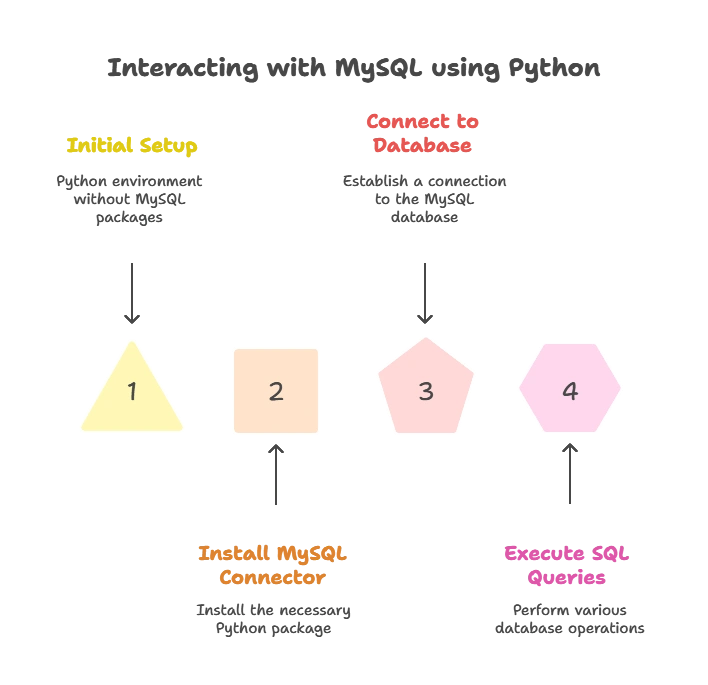Getting Started with MySQL
We'll explore how to interact with MySQL databases using Python. We'll cover everything from installing the necessary packages to executing SQL queries and performing various database operations.
Introduction to MySQL and Python
What is MySQL?
MySQL is an open-source relational database management system (RDBMS) that is widely used for storing and managing data.
Why Use MySQL with Python?
Python provides several libraries and modules for interacting with MySQL databases, making it easy to perform database operations within Python scripts or applications.
Installing MySQL Connector for Python
Before we begin, you’ll need to install the MySQL Connector for Python, which allows Python programs to access MySQL databases.
You can install it using pip, the Python package manager, by running the following command:
pip install mysql-connector-python

Connecting to a MySQL Database
Establishing a Connection
To connect to a MySQL database from Python, you first need to establish a connection using the connect() function provided by the MySQL Connector module.
import mysql.connector
# Establish connection
conn = mysql.connector.connect(
host="localhost",
user="username",
password="password",
database="database_name"
)
# Check if connection is successful
if conn.is_connected():
print("Connected to MySQL database")
else:
print("Failed to connect to MySQL database")
Explanation:
- We import the
mysql.connectormodule, which provides functions for interacting with MySQL databases. - We use the
connect()function to establish a connection to the MySQL database, providing the host, username, password, and database name as parameters. - We check if the connection is successful using the
is_connected()method.
Closing the Connection
It’s important to close the connection after performing database operations to free up resources.
# Close connection
conn.close()
print("Connection closed")
Executing SQL Queries
Executing SELECT Queries
You can execute SELECT queries to retrieve data from MySQL tables using the cursor() method to create a cursor object and the execute() method to execute SQL queries.
# Create cursor
cursor = conn.cursor()
# Execute SELECT query
cursor.execute("SELECT * FROM table_name")
# Fetch results
results = cursor.fetchall()
for row in results:
print(row)
# Close cursor
cursor.close()
Explanation:
- We create a cursor object using the
cursor()method. - We execute a SELECT query using the
execute()method, passing the SQL query as a parameter. - We use the
fetchall()method to retrieve all rows returned by the query. - We iterate over the results and print each row.
- Finally, we close the cursor.
Executing Other Types of Queries
You can execute other types of SQL queries such as INSERT, UPDATE, and DELETE using the execute() method.
# Execute INSERT query
cursor.execute("INSERT INTO table_name (column1, column2) VALUES (%s, %s)", (value1, value2))
# Execute UPDATE query
cursor.execute("UPDATE table_name SET column1 = %s WHERE column2 = %s", (new_value, condition_value))
# Execute DELETE query
cursor.execute("DELETE FROM table_name WHERE condition")
Explanation:
- We execute INSERT, UPDATE, and DELETE queries using the
execute()method, passing the SQL query as a parameter. - For INSERT queries, we provide the values to be inserted as a tuple.
- For UPDATE queries, we provide the new value and condition value as a tuple.
- For DELETE queries, we specify the condition for deleting rows.
Working with Data in MySQL
Creating Tables
To create tables in MySQL, you can execute CREATE TABLE queries using the execute() method.
# Execute CREATE TABLE query
cursor.execute("CREATE TABLE IF NOT EXISTS table_name (id INT AUTO_INCREMENT PRIMARY KEY, name VARCHAR(255), age INT)")
Explanation:
- We execute a CREATE TABLE query using the
execute()method, specifying the table schema. - In this example, we create a table with columns for id, name, and age.
Inserting Data
You can insert data into MySQL tables using INSERT queries.
# Execute INSERT query
cursor.execute("INSERT INTO table_name (name, age) VALUES (%s, %s)", ("John", 30))
# Commit changes
conn.commit()
Explanation:
- We execute an INSERT query using the
execute()method, providing the values to be inserted as a tuple. - After inserting data, we need to commit the changes using the
commit()method to make them permanent.
Updating Data
To update existing data in MySQL tables, you can execute UPDATE queries.
# Execute UPDATE query
cursor.execute("UPDATE table_name SET age = %s WHERE name = %s", (35, "John"))
# Commit changes
conn.commit()
Explanation:
- We execute an UPDATE query using the
execute()method, specifying the new value and condition. - After updating data, we need to commit the changes using the
commit()method.
Deleting Data
You can delete data from MySQL tables using DELETE queries.
# Execute DELETE query
cursor.execute("DELETE FROM table_name WHERE name = %s", ("John",))
# Commit changes
conn.commit()
Explanation:
- We execute a DELETE query using the
execute()method, specifying the condition for deleting rows. - After deleting data, we need to commit the changes using the
commit()method.
Advanced Database Operations
Transactions
Transactions allow you to execute a series of database operations as a single unit of work, ensuring data integrity.
# Begin transaction
conn.start_transaction()
try:
# Execute multiple queries
cursor.execute("INSERT INTO table_name (name) VALUES (%s)", ("Alice",))
cursor.execute("UPDATE table_name SET age = %s WHERE name = %s", (25, "John"))
# Commit transaction
conn.commit()
print("Transaction committed successfully")
except:
# Rollback transaction on error
conn.rollback()
print("Transaction rolled back")
Explanation:
- We begin a transaction using the
start_transaction()method. - We execute multiple queries within the transaction.
- If all queries execute successfully, we commit the transaction using the
commit()method. - If an error occurs during execution, we roll back the transaction using the
rollback()method to revert changes.
Error Handling
It’s essential to handle errors gracefully when working with databases to ensure robustness.
try:
# Execute query
cursor.execute("SELECT * FROM non_existent_table")
except mysql.connector.Error as err:
print("Error:", err)
Explanation:
- We use a try-except block to catch any errors that occur during query execution.
- If an error occurs, we print the error message using the
errobject.
We've covered the basics of working with MySQL databases in Python, including establishing connections, executing SQL queries, and performing various database operations. We've also explored advanced topics such as transactions and error handling.By mastering these concepts, you'll be well-equipped to interact with MySQL databases efficiently and effectively using Python. Happy Coding!❤️
